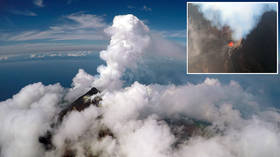Researchers fly drones straight INTO some of world’s most active volcanoes to improve early warning systems

Volcanologists working to improve early warning systems that predict major eruptions more accurately have reported their findings after flying hi-tech drones into an active volcano in Papua New Guinea.
Manam Motu is located on a small island off the northeast coast of Papua New Guinea that’s home to over 9,000 people, and is one of an estimated 300 active volcanoes on Earth. A 2004 eruption forced a complete evacuation of the island and devastated homes, crops, and livelihoods.
An international team including members from the Deep Carbon Observatory flew specially adapted drones directly into Manam’s plumes to better understand the volcano’s emissions, and the clues about future eruptions that might be contained therein.
Improved early warning systems are crucially important for saving lives and adequately planning for emergencies. At present, volcanologists typically monitor seismic activity and watch for bulges indicating magma buildup in the volcano walls to anticipate eruptions.
But improved understanding of the chemistry within the volcano might lead to more accurate forecasting of future eruptions.
The team of researchers, led by volcanologist Dr. Emma Liu, from University College London, conducted close flyovers of the volcano in October 2018 and May 2019. Their findings have just been published in the journal Science Advances.
The two types of long-range drones were equipped with gas sensors and cameras, as well as miniaturized gas sensors, spectrometers, and sampling devices, and monitored emissions for telltale signs of an impending eruption event.
The drones flew straight through the volcano’s smoke and gas plume at altitudes of 2,000 metres (6,561ft) some six kilometers (3.7 miles) from the launchpad.
They both took highly accurate measurements of ambient gases around Manam’s two craters, while also collecting samples for analysis on landing back at the pad, which were then compared to satellite measurements.
The readings taken by the drones showed degassing at the volcano’s southern crater between October 2018 and May 2019 and, sure enough, the volcano erupted in June 2019, just one month after the team departed.
The team cautions that volcanic emissions alone are not a reliable indicator of impending eruption, but these more accurate readings may provide yet another useful tool in the volcanic eruption early warning arsenal.
For instance, the ratio of the gasses in the plume might yield more detailed insights, such as the proximity of hot magma to the surface, as well as detecting the large CO2 ‘belches’ that are believed to precede large eruptions, though these are yet to be confirmed as indicators of impending eruptions.
Think your friends would be interested? Share this story!













